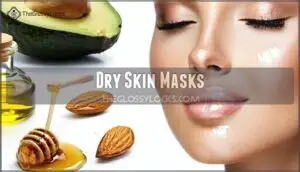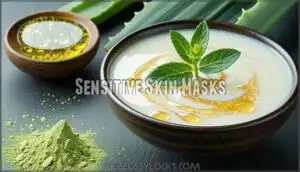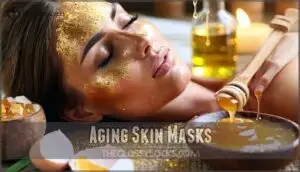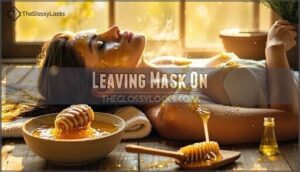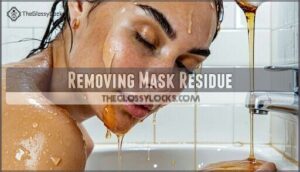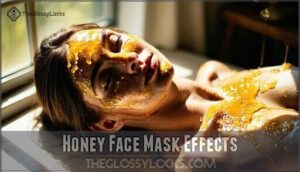This site is supported by our readers. We may earn a commission, at no cost to you, if you purchase through links.

You’ll apply raw honey directly to clean skin, letting its natural enzymes and antimicrobial properties work their magic.
Honey pulls moisture from the air into your skin while gently killing acne-causing bacteria.
It’s gentle enough for sensitive skin yet powerful enough to tackle stubborn breakouts.
Mix honey with oatmeal for exfoliation or yogurt for extra hydration.
Leave your honey face mask on for 15-20 minutes, then rinse with warm water.
Your skin will feel softer and look clearer almost immediately.
The secret lies in choosing the right honey type and knowing exactly how to customize your mask for maximum results.
Table Of Contents
- Key Takeaways
- Benefits of Honey
- Choosing Best Honey
- Honey Face Mask Recipes
- Applying Honey Face Masks
- Honey Face Mask Effects
- Safety Precautions
- Frequently Asked Questions (FAQs)
- Is honey mask good for the face?
- How is honey good for your face?
- What is best to mix with honey for the face?
- Do dermatologists recommend honey on face?
- Is a honey mask good for your face?
- What is best to mix with honey for face?
- How long should you leave honey on your face?
- How to make a honey mask for the face?
- How often should I use honey face masks?
- Can honey face masks cause skin irritation?
- Conclusion
Key Takeaways
- You’ll get powerful antibacterial and moisturizing benefits from raw honey face masks, which naturally fight acne-causing bacteria while drawing moisture from the air into your skin.
- You can customize your honey masks with simple kitchen ingredients like oatmeal for exfoliation, yogurt for hydration, or turmeric for brightening to target your specific skin concerns.
- You should apply honey face masks 2-3 times weekly for 15-20 minutes, choosing raw, unfiltered honey over processed varieties to maximize the natural enzymes and antibacterial properties.
- You must patch test first and avoid the eye area when applying honey masks, especially if you’re allergic to bee products or using ingredients like lemon juice that increase sun sensitivity.
Benefits of Honey
Honey naturally fights bacteria on your skin while pulling moisture from the air to keep your face hydrated.
This golden ingredient also reduces inflammation and provides antioxidants that protect your skin from daily damage.
Antibacterial Properties
Behind honey’s golden sweetness lies a powerful antibacterial army that transforms your skin.
Nature’s golden warrior wages war against bacteria, leaving your skin victorious and glowing.
When you apply a honey face mask, you’re deploying nature’s own antibiotic against acne-causing bacteria while promoting skin healing through sebum control.
Here’s what honey’s antibacterial properties deliver:
- Acne reduction – Destroys P. acnes bacteria before breakouts start
- Wound healing – Accelerates repair of existing blemishes and scars
- Anti-inflammatory relief – Calms angry, red skin naturally
- Long-term protection – Creates hostile environment for harmful bacteria types
Humectant Properties
Think of honey as nature’s moisture magnet.
Its humectant properties work by pulling water from the environment directly into your skin.
This hydration mechanism creates lasting moisture retention that beats most commercial moisturizers.
To optimize these effects, consider how environmental humidity impacts honey’s efficacy.
Different honey types offer varying levels of this benefit, making a honey face mask perfect for boosting skin hydration naturally.
| Moisture Source | How Honey Helps | Your Skin’s Response |
|---|---|---|
| Air humidity | Draws water molecules | Plumper, softer texture |
| Deep skin layers | Prevents water loss | Lasting hydration |
| Environmental factors | Creates protective barrier | Shields from dryness |
| Skin barrier function | Strengthens natural defenses | Improved moisture retention |
Anti-Inflammatory Effects
Honey’s antiinflammatory compounds work like nature’s own ice pack for your face.
When you apply a honey face mask, these calming properties tackle redness reduction and irritation relief head-on.
The soothing effects help control swelling from acne breakouts while providing gentle skin soothing.
You’ll notice less angry-looking inflammation after regular use, making honey perfect for temperamental skin, and its effects contribute to overall inflammation relief.
Antioxidant Properties
Your skin battles free radical damage daily from pollution and UV rays.
Your skin fights an invisible war against pollution and sun damage every single day.
Dark honey varieties pack more antioxidants than their lighter cousins, making them antioxidant-rich powerhouses for environmental skin protection.
Here’s what honey’s antioxidant types deliver:
- Slower skin aging – keeping wrinkles at bay
- Enhanced cellular repair – helping damaged skin bounce back
- Boosted antioxidant bioavailability – maximizing your honey face mask benefits
Skin Barrier Health
Your skin’s protective barrier acts like a bouncer at an exclusive club – it decides what gets in and what stays out.
Honey face masks strengthen this essential defense system by supporting ceramides and promoting microbiome balance.
The natural lipid protection reduces TEWL (transepidermal water loss) while calming skin inflammation.
This barrier strengthening keeps your skin moisturizing itself effectively.
Choosing Best Honey
Quality-sourcing transforms your honey face mask from good to game-changing. You’ll want to skip the grocery store squeeze bottles and hunt for the real deal.
Raw vs. processed makes all the difference – raw honey keeps its natural enzymes and antibacterial powers intact, while processed varieties lose these skin-loving benefits through heating and filtering.
Honey color matters more than you’d think. Darker varieties pack more antioxidants, giving your skin extra protection against free radicals. Don’t stress if you can’t afford premium manuka honey – buckwheat and wildflower varieties offer similar benefits at friendlier prices.
Here’s your shopping checklist:
- Look for organic certification to avoid pesticide residues
- Choose local sourcing when possible for maximum freshness
- Seek "raw" and "unfiltered" labels for maximum honey benefits
Your skin deserves ingredients that actually work, not marketing fluff. You can find quality raw honey online.
Honey Face Mask Recipes
You can create effective honey face masks by mixing raw honey with simple ingredients found in your kitchen.
These natural recipes target specific skin concerns like acne, dryness, and aging while providing gentle care for every skin type, which includes addressing issues with acne.
Acne-Prone Skin Masks
Breakouts demand targeted action, and these honey face mask recipes deliver serious acne-fighting power.
The antibacterial properties in raw honey naturally combat acne-causing bacteria while reducing inflammation. For overnight masks, apply plain honey as a spot treatment. Many users find that a honey acne mask can be beneficial.
Store your honey face mask ingredients properly to maintain potency and maximize ingredient synergy for effective acne treatment.
| Mask Recipe | Application Method |
|---|---|
| Honey + Lemon + Baking Soda | Mix 1 tbsp honey, 1 tsp lemon juice, 1 tsp baking soda |
| Honey + Turmeric | Combine 2 tbsp honey with ½ tbsp turmeric powder |
| Plain Honey Spot Treatment | Apply 1-2 tbsp raw honey directly to breakouts |
Oily Skin Masks
Your greasy T-zone needs a different approach than breakout-prone areas.
Combine two tablespoons honey with half a tablespoon bentonite clay and a teaspoon apple cider vinegar for serious sebum regulation. This powerhouse trio delivers clay mask benefits while balancing sebum production.
For those seeking alternatives, consider products for oily skin.
The oil-absorbing ingredients work together for pore cleansing and pore minimizing effects. Apply this honey face mask twice weekly to control oily skin without overdrying.
Dry Skin Masks
When dry skin craves deep nourishment, honey face masks deliver powerful hydration boosters that transform parched complexions.
Mix two tablespoons raw honey with half a mashed avocado for creamy textures that moisturize intensely.
This humectant-rich combination creates an effective hydrating mask with gentle exfoliation properties.
Add sweet almond oil infusion for overnight masks that restore your skin’s natural moisture barrier completely, providing a natural moisture solution.
Sensitive Skin Masks
Sensitive skin needs extra TLC, and honey face masks deliver without the drama.
Try mixing Manuka honey with cooked oatmeal for oatmeal soothing that calms skin irritation instantly.
For redness reduction, blend honey with matcha masks and almond oil.
Aloe benefits shine when combined with honey for gentle exfoliation, providing skin calming effects your delicate complexion craves.
Aging Skin Masks
Aging skin needs powerful ingredients that fight time’s effects.
Your honey face mask can target multiple concerns at once.
Mix honey with egg whites and frankincense oil for skin firming and wrinkle prevention.
The antioxidants boost collagen production while supporting skin rejuvenation and elasticity.
- Watch fine lines soften as your skin drinks in nature’s fountain of youth
- Feel years melt away when honey’s age spot lightening power reveals your glow
- Experience the confidence boost as your firmer, smoother skin turns heads again with its glow
Applying Honey Face Masks
You’ll need to prepare your skin properly before applying any honey face mask to get the best results.
Start by washing your face with a gentle cleanser, then use a warm, damp washcloth to open your pores and help the honey penetrate deeper into your skin to achieve the desired outcome.
Preparing Skin for Masks
Your skin’s success with any honey face mask starts with proper prep work.
Cleanse thoroughly with your regular facial cleanser to remove makeup and daily grime.
Open pores by placing a warm, damp washcloth on your face for two minutes.
Exfoliate gently if needed, but skip this step for sensitive skin types.
Always patch test your DIY face mask first.
Mask Application Techniques
Application tools make all the difference when applying your honey face mask.
Clean fingers work perfectly, but a soft brush gives you better control over mask consistency and even coverage.
- Start with clean hands – Wash thoroughly before touching your face
- Apply in upward strokes – Follow your skin’s natural lines for better absorption
- Use gentle massage techniques – Work the mixture into your skin with circular motions
- Layer masks evenly – Build up thin layers rather than one thick application
Leaving Mask On
Once your honey face mask is applied, let it sit for 15-40 minutes.
This ideal duration allows maximum mask absorption, delivering extended benefits like hydration and soothing.
For sensitive skin, stick to shorter times.
Avoid overnight masks unless using raw honey or manuka honey alone, as they’re gentler.
Homemade masks can replenish and moisturize the skin effectively.
Enjoy the face mask benefits while relaxing with maximum mask absorption and feeling the soothing effects.
Removing Mask Residue
After fifteen minutes, it’s time to say goodbye to your honey face mask.
Start with warm water to dissolve the sticky sweetness, then grab a soft face cloth for gentle exfoliation.
Honey also helps maintain a healthy acid mantle by balancing skin pH.
Don’t skip the second rinse—honey’s stubborn like that friend who won’t leave the party.
Follow with toner use to close pores, then finish with moisturizing after for glowing results.
Honey Face Mask Effects
You’ll notice changes in your skin within minutes of applying a honey face mask as it starts reducing bacteria and drawing moisture to the surface.
The effects continue working long after you rinse off the mask, with honey’s natural enzymes helping to speed up healing and gradually fade dark spots over the following days, which is a result of its ability to help with healing.
Reducing Bacteria
After you remove your honey face mask, the real magic happens beneath the surface.
Honey’s antibacterial properties actively combat acne-causing bacteria like Propionibacterium acnes. Different honey types offer varying potency levels, with raw varieties providing maximum bacterial resistance.
Your skin microbiome benefits from this natural acne treatment, making honey face masks an effective antibacterial solution that targets harmful bacteria without disrupting healthy skin flora.
Honey also contains anti-inflammatory compounds to soothe redness.
Exfoliating Skin
Beyond cleansing, honey’s natural enzymes work like tiny cell turnover accelerators on your skin.
The gentle scrubs created by honey’s crystallized granules provide effective skin exfoliation without harsh abrasives.
Here’s how honey face mask exfoliation benefits you:
- Enzyme Action dissolves dead skin cells naturally
- Granule Size offers controlled physical exfoliation
- Post-Exfoliation skin appears brighter and smoother immediately
Speeding Up Healing
When cuts, scrapes, or acne breakouts happen, honey’s antibacterial properties jump into action like your skin’s personal medic.
Studies show honey for skin accelerates wound healing time by creating an ideal healing environment that prevents infection.
The anti-inflammatory benefits reduce swelling while promoting faster tissue repair, making those pesky blemishes disappear quicker than usual.
Fading Scars
Honey’s natural enzymes work wonders for stubborn acne scars and skin discoloration.
The glucose oxidase creates gentle peeling action while antioxidants promote cellular renewal. You’ll see gradual lightening with consistent application – use honey masks three times weekly for the best results.
Darker honey varieties pack more skin healing nutrients, making them perfect for addressing various scar types and evening out your complexion naturally, with consistent application.
Safety Precautions
Before you apply any honey face mask, you must check for allergies to honey, bee pollen, or bee venom since reactions can cause serious skin irritation.
You should also avoid the eye area completely and wear sunscreen the next day if your mask contains lemon juice or other ingredients that make your skin sensitive to sunlight.
Allergic Reactions
Testing prevents uncomfortable surprises when using honey masks. Before slathering honey across your face, do a patch test on your inner wrist and wait 24 hours.
Watch for reaction symptoms like redness, itching, or swelling.
Signs you shouldn’t proceed:
- Raised bumps or hives appear within hours
- Burning sensation develops on contact
- Skin becomes inflamed or severely irritated
Consider alternative options if allergic reactions occur, as this is a clear indication that you should not proceed with using the honey mask.
Pollen Allergies
If you’re allergic to bee pollen, honey face masks can trigger cross-reactivity reactions.
Allergy symptoms include itching, swelling, or rashes.
Always perform a patch test on your inner wrist before applying any honey face mask.
Check the honey source – some varieties contain more pollen than others.
Consider desensitization options with your doctor if you experience skin sensitivity but want to use honey skincare treatments.
Avoiding Eye Area
Keep your honey face mask away from your delicate eye area to prevent irritation risks and eye sensitivity.
The skin around your eyes is thinner and more vulnerable to natural skincare ingredients.
Apply your DIY skincare mask with precision, staying at least half an inch from your lash line.
This application precision guarantees product safety and prevents mask migration into sensitive zones.
Sun Protection
Certain honey mask ingredients increase UV exposure sensitivity, especially lemon juice. Your skin becomes more vulnerable to sun damage for 24 hours after application.
Apply sunscreen with SPF 30 or higher the next day for proper skin protection. Mask timing matters – evening applications work best.
Wearing sun-protective hats can also minimize sun exposure. This post-mask care routine protects your natural skincare investment and prevents irritation.
Frequently Asked Questions (FAQs)
Is honey mask good for the face?
Like nature’s skincare goldmine, honey masks work wonders for your face.
They’re naturally antibacterial, fight acne, hydrate skin, and reduce inflammation.
You’ll get clearer, softer skin with fewer breakouts and a healthy glow.
How is honey good for your face?
Honey naturally fights acne-causing bacteria while drawing moisture to your skin.
It’s packed with antioxidants that slow aging signs and gently exfoliates dead cells.
You’ll notice reduced inflammation and a natural glow.
What is best to mix with honey for the face?
Oatmeal creates the perfect partnership with honey, gently exfoliating while soothing irritation.
You’ll love mixing yogurt for extra hydration, turmeric for brightening, or avocado for deep moisture—each combination targets your skin’s specific needs beautifully.
Do dermatologists recommend honey on face?
Yes, dermatologists frequently recommend honey for facial skincare. You’ll benefit from its natural antibacterial and anti-inflammatory properties, which help reduce acne and soothe irritated skin while providing gentle hydration.
Is a honey mask good for your face?
You’ll love how honey masks naturally moisturize, fight acne-causing bacteria, and reduce inflammation. They’re gentle enough for daily use and work wonders for all skin types, leaving you glowing.
What is best to mix with honey for face?
For oily skin, mix honey with bentonite clay or lemon juice.
Dry skin loves honey with avocado or yogurt.
Sensitive skin benefits from honey with oatmeal.
You’ll get targeted results based on your skin’s needs.
How long should you leave honey on your face?
Leave honey on your face for 15-20 minutes to get the best results. This gives it enough time to hydrate your skin and work its antibacterial magic without overdoing it.
How to make a honey mask for the face?
Creating your own natural skincare remedy is like crafting liquid gold for your complexion.
Simply mix two tablespoons of raw honey with your chosen ingredient—oatmeal, lemon, or avocado—then apply evenly across clean skin.
How often should I use honey face masks?
You can safely use honey face masks 2-3 times per week for most skin types.
Daily use works for gentle varieties like plain honey, but stronger ingredient combinations need spacing to prevent irritation.
Can honey face masks cause skin irritation?
Most people tolerate honey well, but you might experience irritation if you’re allergic to bee products.
Raw honey can sometimes cause mild reactions. Always patch-test first, especially with added ingredients like lemon.
Conclusion
Transform your skincare routine forever with these game-changing honey face mask recipes.
You’ve discovered how raw honey’s antibacterial and moisturizing properties can tackle acne, dryness, and inflammation naturally.
Choose high-quality honey and customize your masks with ingredients like oatmeal or yogurt for your specific skin type.
Apply these masks 2-3 times weekly for best results.
Remember to patch test first and avoid the eye area.
Your skin will thank you for this simple yet powerful natural treatment.
- https://www.researchgate.net/publication/259200803_Honey_in_dermatology_and_skin_care_A_review
- https://www.webmd.com/vitamins/ai/ingredientmono-738/honey
- https://www.irjmets.com/uploadedfiles/paper/issue_5_may_2023/39199/final/fin_irjmets1684399737.pdf
- https://pubmed.ncbi.nlm.nih.gov/24305429/
- https://www.mdpi.com/1424-8247/17/12/1709




